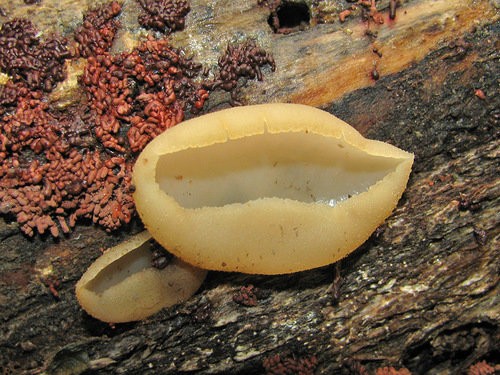Variable pepper (Peziza varia)
- Department: Ascomycota (Ascomycetes)
- Subdivision: Pezizomycotina (Pezizomycotins)
- Class: Pezizomycetes (Pezizomycetes)
- Subclass: Pezizomycetidae (Pezizomycetes)
- Order: Pezizales (Pezizales)
- Family: Pezizaceae (Pezitsaceae)
- Genus: Peziza (Petsitsa)
- Type: Peziza varia (Changeable Peziza)

fruiting body: in young mushrooms it has the shape of a hemisphere, cup-shaped. Then the fruiting body loses its regular shape, dissolves and takes on the shape of a saucer. The edges are often torn, uneven. The inner surface of the body is smooth, brownish in color. The outer side with a matte coating, granular. Outside, the mushroom is a lighter shade than its inner surface. The diameter of the fruiting body is from 2 to 6 centimeters. The color of the fungus can be very diverse from brown to grayish-brown.
Leg: often the stalk is absent, but may be rudimentary.
Pulp: brittle, very thin, whitish color. The pulp does not stand out with a special taste and smell. When the pulp is enlarged in a section with a magnifying glass, at least five of its layers can be distinguished.
Disputes: oval, transparent spores, do not have lipid droplets. Spore powder: white.
Variable pepper is found on the soil and heavily rotted wood. Prefers soil abundantly saturated with wood waste and areas after fires. It grows quite often, but in small quantities. Fruiting time: from the beginning of summer, sometimes even from late spring, until autumn. In more southern regions – since March.
Some mycologists of advanced age claim that the Pezica variable mushroom is a whole genus that includes fungi that were previously considered separate independent species. For example, they include Peziza micropus with a characteristic small leg, P. Repanda, and so on. To date, the family of Petsitsa is becoming more united, there is a tendency to unite. Molecular research has made it possible to combine the three species into one.
True, most of the rest of Peziza, except for Peziza badia, which is larger and darker, does not grow on wood. And if the fungus grows on wood, then it is almost impossible to distinguish it from the variable pezitsa in the field.
It is not known if this mushroom is poisonous or edible. Probably, the whole point is its not high nutritional value. Obviously, no one even tried this mushroom – there is no motivation, due to low culinary qualities.









